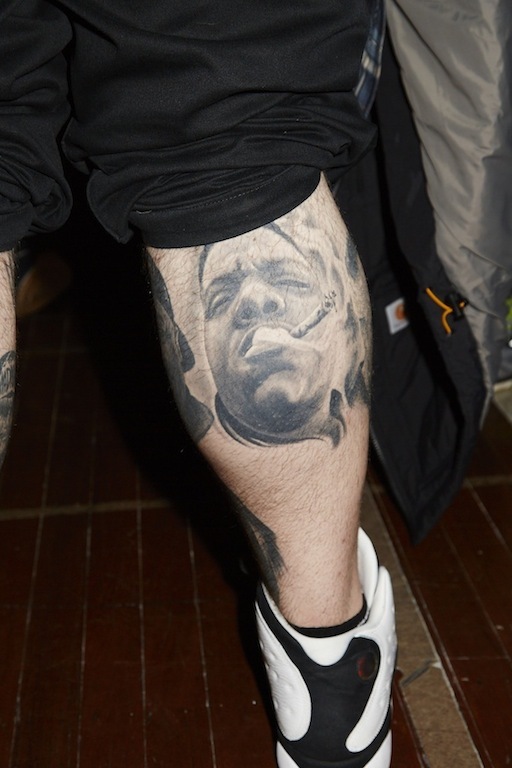This article appears in_ The Incarceration Issue _, a special edition of VICE Australia.Check out the documentary here: LIVE AT JUVIE"I think when there's kids here as young as 10 and 11, that's not a matter of that kid failing. That's everyone else failing that kid, be it society or their parents or whoever else. Because no kid should be locked up when they're 10—that's crazy. Some of your earliest memories are going to be of a place like this. And it's not like the people here don't do great work, and the programs they do instil confidence and self-worth, but ideally you want a kid to be going to the footy, not going to jail."
Advertisement
We're at Reiby Juvenile Justice Centre in south-west Sydney, and Adam Briggs is playing ping-pong with a 14-year-old detainee. The rising hip-hop artist and proud Yorta Yorta man is here to talk to the kids, hear their stories, and to perform a few tracks. We've come along for the ride.
Briggs waiting to be let in
Hailing from the Victorian township of Shepparton, razor-sharp lyricist Briggs has established himself as a key voice in Australian rap. His style reaches beyond the conventions of Aussie hip-hop, with a flow and delivery paying homage to golden-age hip-hop fundamentals while exhibiting storytelling with profound wit. This year saw the release of "The Children Came Back," an empowering sequel to Archie Roach's "They Took the Children Away"—with Briggs name-checking Indigenous Australian heroes accompanied by guest vocals from Gurrumul and Dewayne Everettsmith. The track, which followed last year's album Sheplife as well as tour supports for the likes of Ice Cube, is sure indication Briggs stands as one of Australia's most promising rap talents. But for the moment we're watching him play ping-pong."Getting schooled"might be a more accurate description. His opponent, Jai (not his real name), moves his paddle at a speed that doesn't correspond to his shyness. All the kids we meet here start off shy, but while some manage to overcome it, this one doesn't quite get there. Even so, it's a beatdown. The match ends with Jai ripping a vicious cross-court smash, the kind of shot where the ball disappears for a second, materialising only after it's bounced off the wall and then off the floor. Briggs tilts his head and gives the kid his exaggerated stinkeye. "You been practising?" he asks. "I've been here for five months," says the kid.
Advertisement
Posing for a class photo
Like about half the boys currently at Reiby, Jai is Indigenous. Reiby can hold up to 60 at any one time, and there are some occasions when almost all of them are of Aboriginal descent. While Indigenous over-representation is a constant theme in Australia's prisons, it's more apparent in the juvenile justice system. Last year's New South Wales Justice Annual Report stated that young people of Aboriginal and/or Torres Strait Islander background made up 48 percent of all young people in state custody. The national average in the adult system is 28 percent.Boys come to Reiby for offences ranging from theft and minor assaults, right up to murder. Ages of the detainees start at 10 and go up to 18, and many are repeat visitors. Speaking with a Reiby official over the phone, we're told that reoffending rates are a struggle. Upon release, a lot of the kids go back to situations that led them to offend in the first place. And then there's a lot of them who come to see Reiby as a safe place, more of a home than the ones they're born into. The facility has a weights room, a football field, art classes, video games, and a working cafe where they can learn to make coffee. They have their own rooms and there's a system of consistency and reward for effort. "You see a lot of boys reoffending around their birthdays," says the official. "They may not get a birthday on the outside."
"I was just sitting with a young fella in a suicide vest who just turned 15—he hasn't even lived a life to end."
Advertisement
But it's not a cakewalk either, and some do the time harder than others. Fifteen-year-old Kyle is on a DRMP—a detainee risk management plan. He's playing euchre with two guards when Briggs walks into the room. The guards are in protective gear including helmets with visors; Kyle has been known to lash out and spit. Kyle himself is wearing a thick coverall made of kevlar and velcro—something called a suicide gown. Briggs is invited to sit and play, but he doesn't know euchre so they switch to thirteens.Later, sitting on a picnic table outside, Briggs reflects on the encounter. It turns out he and Kyle knew some of the same people in Albury, and the closeness looks to have hit hard. "I was just sitting with a young fella in a suicide vest who just turned 15—he hasn't even lived a life to end," he says. "It makes me grateful for the strong family that I had around me. So many kids don't get that."
Only certain members of Reiby's population were allowed see Briggs perform, and those who did had to stay seated.
Throughout the day, Briggs meets more and more of Reiby's residents. They show him their classrooms and bedrooms. They bond over the art and NRL posters on their walls. They talk about motorbikes and footy. Briggs is like the ultimate big brother, one who moved out years ago but still comes back to check in and win at Fight Night on the XBox. He knows when to tease them and when to build them up. And when they ask why he's come, his answer is always a version of the same thing: "I'm visiting because I feel like it's important for me to be a positive role model, especially for those fellas who need it the most. Those fellas need to know that people are thinking about them from the outside."
Advertisement
Riot gear at the ready
Performing

The fabric gives inmates some privacy, but allows wardens to keep tabs on them
Briggs
